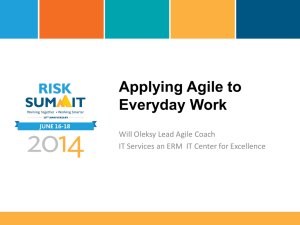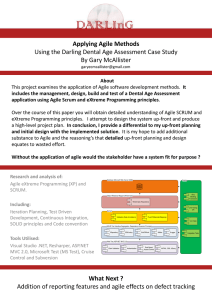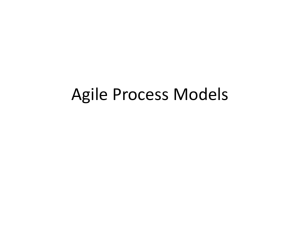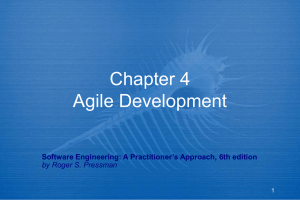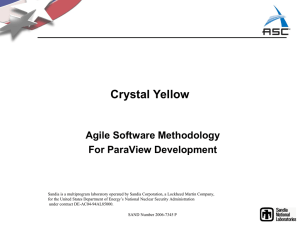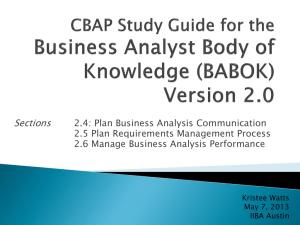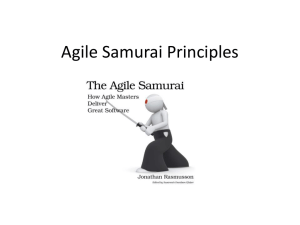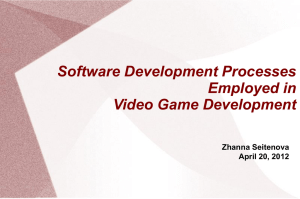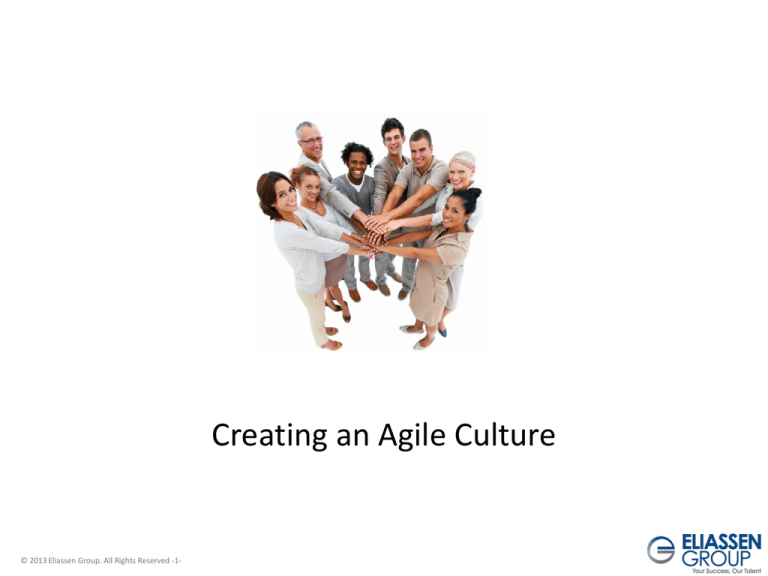
Creating an Agile Culture
© 2013 Eliassen Group. All Rights Reserved -1-
Damon Poole – Chief Agilist, Eliassen Group
• Providing our Clients
– Coaching: Checkups, Transformation, and Tune-ups
– Full Agile Curriculum
• 23 years of process change: small co-located teams to
multi-hundred team global enterprises
• Founder and past CTO and CEO of AccuRev
• Creator of multiple award winning products
• Past President and Vice President of Agile New England
• Author of “DIY Agile Kickstart”
• Consulted with Ford IT, Orbitz, Fidelity, Capital One,
ING Direct, and many others
• Taught Agile techniques to thousands of people
© 2013 Eliassen Group. All Rights Reserved -2-
Agenda
•
•
•
•
•
What is culture?
What is Agile?
Why change?
The core of Agile culture
How to affect change
© 2013 Eliassen Group. All Rights Reserved -3-
A Few Definitions of Culture
cul·ture noun:
- the set of shared attitudes, values, goals, and
practices that characterizes an institution or
organization <a corporate culture focused on the
bottom line>
- a way of thinking, behaving, or working that exists in
a place or organization (such as a business)
- the set of values, conventions, or social practices
associated with a particular field, activity, or societal
characteristic
Merriam Webster Dictionary
© 2013 Eliassen Group. All Rights Reserved -4-
What Defines Culture?
Foundations
•
•
•
•
Goals
Values
Beliefs
Principles
Culture reinforces goals,
values, beliefs, and principles
© 2013 Eliassen Group. All Rights Reserved -5-
Embodied by…
•
•
•
•
•
•
•
•
•
•
•
Behavior
Traditions
Customs
Practices
Taboos
Ceremonies
Rituals
Symbols
Language (Jargon!)
Conventions
Rules / laws
Role-Based Culture
• Split into “teams”
• Try to be as cross-functional as possible
• Each team will be assigned a role to discuss
–
–
–
–
–
–
Developers
Testers
Business people
Managers
Project managers
UX folks
• Come up with a list of beliefs and values for your
team’s assigned role
• Use the context of traditional development, not
Agile
© 2013 Eliassen Group. All Rights Reserved -6-
5 min
Agile
© 2013 Eliassen Group. All Rights Reserved -7-
Agile Techniques Come From the Agile Community
Agile Manifesto
Agile Community
Agile Toolkit
Scrum
User stories
Continuous Integration
TDD
Unit testing
Kanban
XP
SAFe
Enterprise Agility
Etc.
Agile – an adjective that describes anything that supports
the values and principles of the Agile Manifesto.
© 2013 Eliassen Group. All Rights Reserved -8-
Agile Manifesto
Principles
Values
We are uncovering better ways of developing software by doing it and helping others do it.
“Individuals and
interactions over process
and tools”
“Working software
over comprehensive
documentation”
“Customer
collaboration over
contract negotiation”
“Responding to
change over
following a plan”
“Build projects around
motivated individuals,
give them the
environment and
support they need, and
trust them to get the job
done.
“Deliver working
software frequently,
from a couple of weeks
to a couple of months,
with a preference to
the shorter timescale.”
“Business people and
developers must work
together daily
throughout the
project.”
“At regular
intervals, the team
reflects on how to
become more
effective, then tunes
and adjusts its
behavior
accordingly.”
“Agile processes promote
sustainable
development. The
sponsors, developers,
and users should be able
to maintain a constant
pace indefinitely.”
“The best architectures,
requirements, and
designs emerge from
self-organizing teams”
© 2013 Eliassen Group. All Rights Reserved -9-
“Working software is
the primary measure
of progress.”
“Simplicity -- the art of
maximizing the
amount of work not
done – is essential.”
“Continuous attention
to technical excellence
and good design
enhances agility.”
“The most efficient and
effective method of
conveying information
to and within a
development team is
face-to-face
conversation.”
“Our highest priority is
to satisfy the customer
through early and
continuous delivery of
valuable software.”
“Welcome changing
requirements, even
late in development.
Agile processes
harness change
for the customer's
competitive
advantage.”
Exercise: What do you believe?
• Read each value and principle
• How many values and principles resonate with
you?
© 2013 Eliassen Group. All Rights Reserved -10-
5 min
Some Aspects of Traditional vs Agile Culture
Area
Traditional
Agile
Organizational structure
Function & project
Product, team, & delivery
Compensation
Individual based
Includes team and delivery
components
Impediment raising
Rarely raised
Focus on raising & addressing
Management of teams
Directing
Enabling
Business & IT interaction
IT is a cost center
Customer oriented partnership
Teams
Large, functional,
project-based,
transient, & dynamic
Small, cross-functional,
product-based, long standing &
static
Customer Interaction
Requirements and
acceptance
Throughout entire process
Transparency
Low
High
Trust
Low
High
© 2013 Eliassen Group. All Rights Reserved -11-
Why Change?
© 2013 Eliassen Group. All Rights Reserved -12-
Break Everything Down into Minimum Viable Increments (MVIs)
$0
MVI 1
1 2 3
Project
MVI 2A
$300K
$600K
$900K
?
4 5 6 7 8 9 10 11 12 13 14 15 16 17 18
months
© 2013 Eliassen Group. All Rights Reserved -13-
An Example of the Effect of Working by MVI
Receive an
extra $450K
$150K
$0
$450K
MVI 1
MVI 2
1 2 3
4 5 6 7 8 9 10 11 12 13 14 15 16 17 18
months
© 2013 Eliassen Group. All Rights Reserved -14-
The Cost of Too Many Projects in Progress
Project A
Project B
Project C
Project D
Project E
Project F
1 2 3 4 5 6 7 8 9 10 11 12 13 14 15 16 17 18
months
© 2013 Eliassen Group. All Rights Reserved -15-
An Example of the Effect of Limiting Projects in Progress
1 2 3 4 5 6 7 8 9 10 11 12 13 14 15 16 17 18
months
© 2013 Eliassen Group. All Rights Reserved -16-
An Example of the Effect of Limiting Projects in Progress
Project A
Project B
1 2 3 4 5 6 7 8 9 10 11 12 13 14 15 16 17 18
months
© 2013 Eliassen Group. All Rights Reserved -17-
An Example of the Effect of Limiting Projects in Progress
$0
$600K
$1.2M
$2.4M
$3.6M
Project A
Project B
Project C
Receive an
extra $3.6M
Project D
Project E
Project F
1 2 3 4 5 6 7 8 9 10 11 12 13 14 15 16 17 18
months
© 2013 Eliassen Group. All Rights Reserved -18-
The Core of Agile
© 2013 Eliassen Group. All Rights Reserved -19-
Continuous Improvement Management Cycle
Plan
Popularized by
Dr. W. Edwards Deming
© 2013 Eliassen Group. All Rights Reserved -20-
Do
Check
Act
Basic Scrum Cycle
A 1-4 week cycle
Plan
• Higher quality
• Real visibility
• Quick change
© 2013 Eliassen Group. All Rights Reserved -21-
Do
Check
Deliverable
(Actual delivery optional)
Act
Agile Teams… using Traditional Integration
Iteration (Sprint)
Integration
Testing
Hardening
Done!
Done!
Done!
© 2013 Eliassen Group. All Rights Reserved -22-
Agile Within an SDLC
Funding
Req & Est
Design
Plan
Development
Trad Proj Mgmt
int
int
Agile Teams
int
Test
UAT
Release
1 2 3
4 5 6 7 8 9 10 11 12 13 14 15 16 17 18
© 2013 Eliassen Group. All Rights Reserved -23-
Iterations (aka Sprints)
Iterations – regular intervals of time, from 1-4 weeks, in
which the team produces a deliverable increment of work.
Sprints – the term Scrum uses for iterations.
1 2 3
4 5 6 7 8 9 10 11 12 13 14 15 16 17 18
© 2013 Eliassen Group. All Rights Reserved -24-
Multiple Competing Requests
Members of the team are bombarded by conflicting requests
Customer
one
Stakeholder
two
Production
issues
TEAM
Customer
two
© 2013 Eliassen Group. All Rights Reserved -25-
Regressions
Stakeholder
one
The “Locked Room”
ENTER
EXIT
Definition
of Ready
Definition
of Done
1)
2)
3)
4)
5)
6)
7)
8)
Asdf asdf qwerty asdf.
Qwerty asdf hj klm.
Asdfasdf qwert jkl.
If you can read this you are way too close.
No, really, back up.
Why are you still reading this?
Must pass all performance tests
Graphics do not contain the color red.
1)
2)
3)
4)
5)
6)
7)
8)
Asdf asdf qwerty asdf.
Qwerty asdf hj klm.
Asdfasdf qwert jkl.
If you can read this you are way too close.
No, really, back up.
Why are you still reading this?
Must pass all performance tests
Graphics do not contain the color red.
BACKLOG AGILE TEAM
Exercise: in “teams” create list of potential behavior changes
© 2013 Eliassen Group. All Rights Reserved -26-
• Benefit: travelling 3,000 miles in 6 hours for $400
© 2013 Eliassen Group. All Rights Reserved -27-
• Benefit: travelling 3,000 miles in 6 hours for $400
• Plane
– Aerodynamic body
– Control surfaces
– More lift than weight
– Landing gear
• Trained pilot (s)
• At least two runways
© 2013 Eliassen Group. All Rights Reserved -28-
Change is Difficult
© 2013 Eliassen Group. All Rights Reserved -29-
Cultural Changes to Make
• What needs to change?
– Personally?
– In your organization?
• One item per card, write:
–
–
–
–
–
–
Beliefs that are contrary to Agile, mark ‘B’
Values that are contrary to Agile, mark ‘V’
Things at risk, mark “R”
Concerns about Agile, mark “C”
Impediments to Agile, mark “I”
Adaptations to Agile, mark “A”
© 2013 Eliassen Group. All Rights Reserved -30-
Making a Change
• Hold up your card from earlier…
© 2013 Eliassen Group. All Rights Reserved -31-
Typical Problems When Making Big Organizational Changes
• Accepting a lack of urgency
• “This is really just a small change”
• Confusion
–
–
–
–
–
•
•
•
•
What are we doing?
Why are we doing it?
Who is doing it?
How will we do it?
What’s in it for me… and when?
Status-quo messages drown out messages about changes
Failure to remove obstacles
Lack of short-term wins, or lack of visibility of those wins
Declaring victory too soon
© 2013 Eliassen Group. All Rights Reserved -32-
Establish a sense of Urgency
Create an Agile Transformation Vision
Empower the organization
• Remove obstacles
• Change the system
• Support learning (“failing fast”)
Plan for ongoing wins
Continue until the new ways have
become “The way we do things
around here”
Based on the Kotter Change Model.
The Kotter Change Model was first
published in 1995.
© 2013 Eliassen Group. All Rights Reserved -33-
Form a
Guiding
Coalition
Constant Communication
Kotter Change Model for Agile
Next Steps / Q&A
• Consider how you personally can affect change
Damon Poole
dpoole@eliassen.com
@damonpoole
eliassenagileblog.com
© 2013 Eliassen Group. All Rights Reserved -34-



